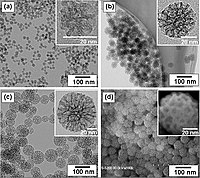
Photo from wikipedia
In the present work, undoped and Cu-doped ZrO2 nanoparticles with a different weight percentage of copper (0 to 0.05 wt%) are synthesized by sol–gel technique. From XRD analysis, the observed… Click to show full abstract
In the present work, undoped and Cu-doped ZrO2 nanoparticles with a different weight percentage of copper (0 to 0.05 wt%) are synthesized by sol–gel technique. From XRD analysis, the observed peaks corresponding to the plane match well with the JCPDS data of tetragonal ZrO2. Microstructural analysis shows that the average crystallite size decreases from 6.96 to 5.73 nm when the Cu content increases from 0 to 0.05 wt%. From FTIR analysis the peaks observed at 489 and 429 cm−1 confirm the tetragonal Zirconia. From the morphology, the shape of the synthesized nanoparticles is observed to be spherical and the average particle size (using ImageJ) is found to vary from 30 to 7.18 nm when the dopant concentration increases from 0 to 0.05 wt%. The presence of Zr, Cu, and O in the prepared samples are confirmed by EDS analysis. The optical analysis shows that the optical absorption is blue-shifted when Cu content increases from 0 to 0.05 wt% and it is attributed to the confinement of charge carriers. Bandgap (Eg) analysis shows the transitions are direct allowed and the Eg value increases from 3. 27 to 3. 35 eV when Cu content increases from 0 to 0.05 wt%. From PL analysis, the peak at 389 nm is attributed to the ionized oxygen vacancies (F and F centers) from CB. From the photocatalytic analysis, undoped and Cu-doped ZrO2 used as the catalyst for the degradation of Alizarin Yellow is found to be faster for 0.05 wt% of Cu-doped ZrO2 (S3) than undoped (S1) and 0.03 wt% of Cu-ZrO2 (S2) which is attributed to the crystallite size of the 0.05 wt% of Cu-doped ZrO2 nanoparticles.
Journal Title: Journal of Inorganic and Organometallic Polymers and Materials
Year Published: 2020
Link to full text (if available)
Share on Social Media: Sign Up to like & get
recommendations!